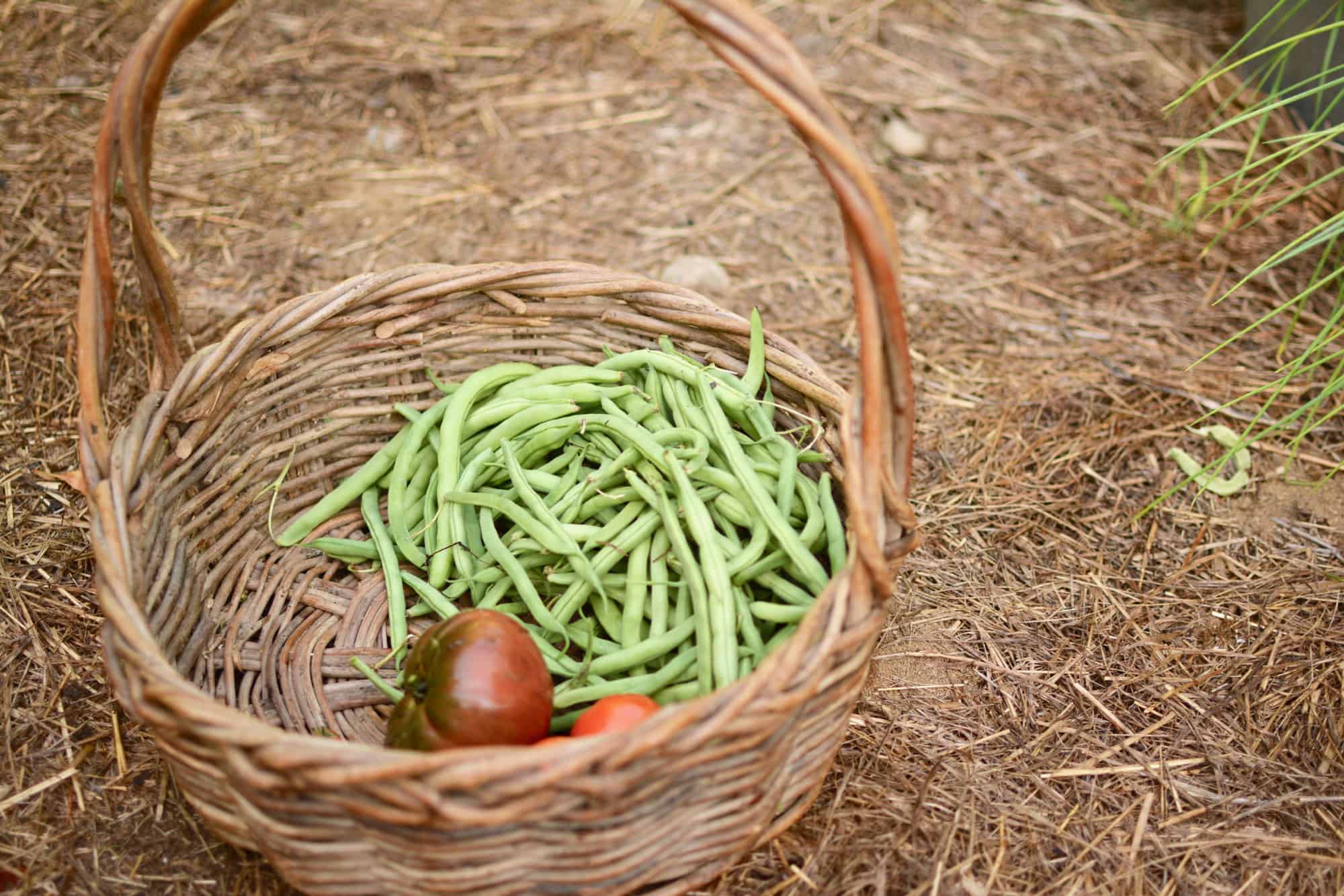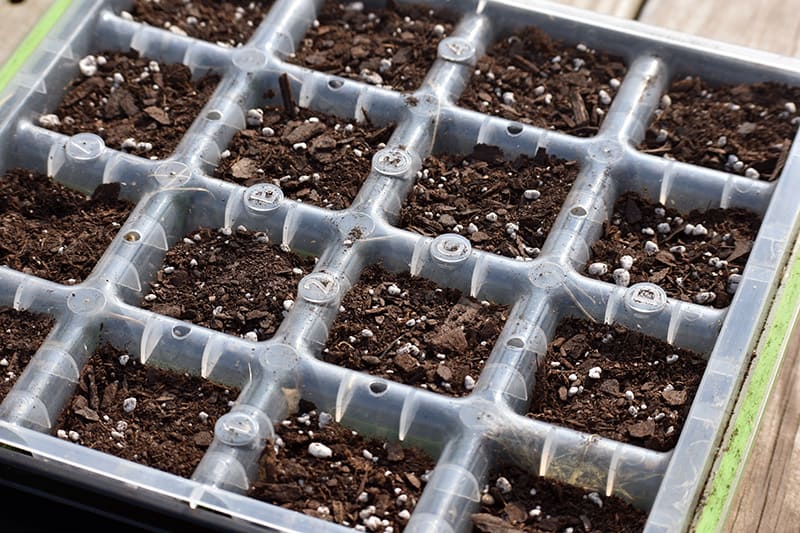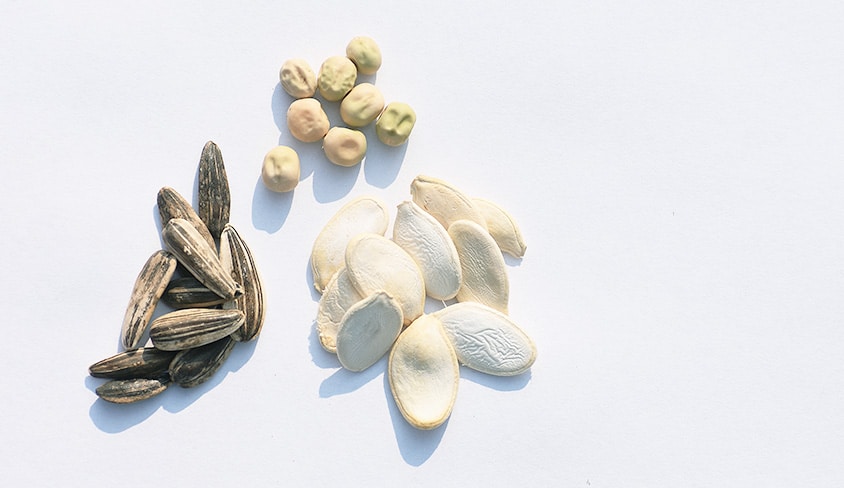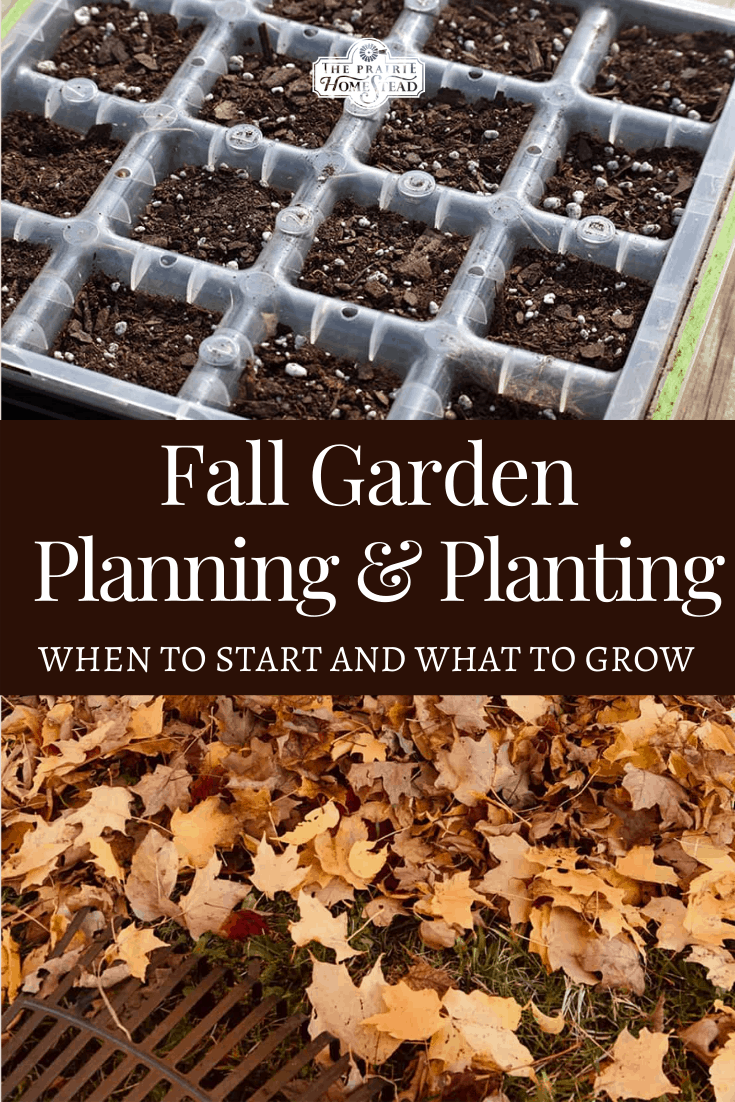Most folks assume that once summer is over, then the gardening season is complete.
But did you know there is a whole other world of gardening possibilities? Possibilities that can help increase your harvest and even passively improve your soil.
Yep, I’m talking about fall gardening. I’ve kinda talked a bit about fall gardening in the past by listing 21 vegetables you can plant in a fall garden. However, that article didn’t get into the details on planning a fall garden or why you should have a fall garden in the first place.
I’m going to be completely honest, for the longest time, the idea of fall gardening completely confused me. I would hear people talk about fall gardening and all I could think about was how short our growing season is here in Wyoming and how it didn’t make sense to even attempt a fall garden.
I remember thinking “how can I plant seeds in the fall when I would have to try to harvest the plants in snow?” Thankfully, I have a much better understanding of planning a fall garden now. So I’m going to take you through some of the lesser-known steps you can take in the fall to seriously impact your garden’s productivity.
By the way, even if you don’t want to mess with a fall garden, there are still lots of great things you can do to extend your summer garden longer and into the fall season. Check out my tips here on how to extend your summer garden season.

Why Plant a Fall Garden?
For the longest time, I didn’t understand the power of stretching your garden seasons. I was in this mindset where the garden had to be planted in the spring and harvested in the early fall. The End.
If you can think outside the box and do things differently, it will impact your homestead garden drastically. A fall garden can increase the amount of food you grow and also improve your soil for success in the spring.
Some are probably thinking “Jill, summer kicks my butt, I’m not sure I want to keep growing.” I have been there and totally get that feeling. There is no shame if you feel like you have been through the garden gauntlet and just need a break.
But if you think you have a little bit of juice left and feel like you might have more energy to put into homesteading, fall gardening might be worth your time. Fall vegetable options are a little more limited but fall gardening does have its benefits.
Benefits of Planting a Fall Garden
1) Fewer Bugs
The first benefit from fall gardening that I always think of is fewer bugs. These plants are going to be in their prime after your first frost. This depends on where you live, but usually, the bad bugs are going to be dead. Those Cabbage Moths and annoying things that have been eating holes in the greens will be all gone.
2) Less Heat, Happier Vegetables
Most vegetables that you are planting in your fall garden are a thousand times happier when they are not in heat. This is very applicable if you live in a state or a place with really hot summers. I am in Wyoming and summers are not like they are down south, but I have a heck of a time getting spinach to grow without immediately bolting from the heat. Fall Gardening is cooler, and a lot of these plants are much happier, and you won’t have to fight with plants constantly going to seed or bolting.
3) Fall Gardening Can Be Less Hectic
It depends on your schedule, but fall is sometimes less hectic compared to summer. Doing stuff in your fall garden might feel a little bit more relaxed and maybe a bit more enjoyable.

The Best Vegetables For A Fall Garden
You want to steer clear of vegetables that are sensitive, like tomatoes, cucumbers, squash, and melons. You will want to avoid vegetables that you see turn black after one little temperature dip. Those are the types of vegetables you want to save for the summer garden.
There is this whole other realm of gritty, hardy, tough vegetables that are like “go ahead freeze, I can handle it”. When I think of cold-hardy vegetables, I believe there are 3 categories that do really well in the fall: the cabbage family, greens, and root vegetables.
By the way, my favorite place to buy vegetable seeds is True Leaf Market. They have tons of great selections and I’ve been impressed with all of the seeds that I have planted from them so far. They also have a handy ‘hardiness zone’ area on the left-hand side when you select a specific vegetable, so that you can look at only the vegetables that grow in your hardiness zone. I love them!
Fall Garden Vegetable Categories
1) The Cabbage Family
This family is your brassicas you have broccoli, brussels sprouts, cabbage, and cauliflower. These all handle the cold and are great additions to add when planning your fall garden. Bonus: some of these taste even better after a few frosts (especially brussels sprouts).
2) Greens
Spinach, Chard, Mustard Greens, and Lettuce are easy to grow and should be considered when planting your fall garden. Last year I grew Mache, it is tough as nails, and did well in the cold. There are also greens like kale or arugula that do really well with cold weather and can handle some light frosts.
Most of these plants are very susceptible to pests, like our previous incident with the kale and grasshoppers. Greens are less likely to have these pest problems in the fall, so it’s way less time-consuming to have them in a fall garden since you don’t have to pick off all the bugs as much.
3) Root Vegetables
To be perfectly honest I don’t plant in this category very much, but root vegetables are great for a fall garden. Root vegetables to plant in the fall include radishes, beets, and carrots. Radishes grow lightning fast; beets are a little bit slower but if you harvest them when they are small, they taste better. Some people will grow their second crop of carrots in the fall. All of these root vegetable options are great for planting in your fall garden.

Garlic
One specific crop you will always want to plant in the fall is garlic. I usually plant my garlic at the end of September or the 1st of October for my zone. Make sure you plant your garlic according to your garden zone. Learn your garden zone here and then learn when to plant garlic in your garden zone from my how to grow garlic article.
Garlic grows over the winter, so you will get a little bit of growth, you mulch it, and it just hangs out until spring. In the spring, your garlic starts to come up through the soil, you water it, and then harvest it at the end of June or early July (depending on your garden zone).
When planning a fall garden make sure you set aside some room for the garlic. An important thing to remember is to put a marker where you planted it. In the spring when I get back out to the garden, I often forget which beds they are in and I often second-guess myself.
There are some awesome options when it comes to fall planting, and I know there are at least 21 Vegetables For Your Fall Garden, within these categories. All of these cold-hardy vegetables are the ones you will want to focus on for fall.
Figuring Out Fall Planting Dates
The next piece of this puzzle is figuring out WHEN you should start planting your fall garden. This is the part that will catch many off-guard. A fall garden is a bit of a misnomer because you don’t start a fall garden in the fall, you start it in the summer.
In July, you’re not thinking about planting seeds, you’re thinking about weeding and garden care. You are full-swing in summer gardening and it can be hard to remember to start your fall garden.
For a successful fall gardening start, you will need to go back to planting-mode and get ready to plant your fall crops by mid-summer. Some seeds can be directly sown into the garden, while others will need to be started indoors. Dust off the grow lights, get the shelves cleaned off, and get ready to start some fresh seedlings.
Additional Seed Starting Help:
- Listen to my Seed Starting podcast episode (where I talked about seed-starting in the basement)
- Simple DIY Seed Starting System
- Seed Starting Guide
- Seed Starting Tips (video)
Finding Your Frost Date
You already know your last frost date for spring, now you are going to find your first frost date for fall. My first frost date on average is around September 15th, and anything past this in the garden is in the danger zone for frosts and even blizzards.
Starting Fall Garden Seedlings – 12 Weeks Before Frost
Figuring out your planting date is pretty simple now that you know your first frost date. You will find your first frost date and count back roughly 12 weeks, the date you land on should be when you are starting your seedlings indoors.
12 weeks before my first frost date brings me to the end of June. The planting of my main garden is done by June 1st, so fall planting comes very early for my short season. Once my main garden has been planted, I only have a month until I have to get back in seedling mode.
This is when I need to start any of the cabbage family, they tend to germinate better when it’s not blazing hot. This includes cabbage, broccoli, and cauliflower, if you are planning on growing any members of the cabbage family this is the time to plant indoors.
You could also start the chard or some of the greens inside but in my experience, they honestly do better when planted straight into the garden.

Transplanting Fall Garden Seedlings – 10 Weeks Before Frost
10 weeks, about 2 weeks after you have started your seeds indoors, you will want to transplant them to your garden. Your summer garden should be in full swing, so all you will need is a well-protected clean bed. These baby plants will need a little extra protection from both the elements and any pests your main garden is attracting.
10 weeks out from your first frost you can also direct sow some of the other vegetables into your garden. This is the time to plant your lettuce, and also your root veggies like the carrots, beets, and radishes.
These are the fast-maturing crops that you can repeat sow from the middle of July to the beginning of August. I usually keep planting a few hardy things like spinach, mache, and a few more bits of lettuce. Here’s a list of fast-growing vegetables that you can add to your garden throughout the summer and into early fall.
You want to make sure your plants have a good start with enough time to get growing and germinating. At this point, you are now moving into the time when they need to be a little stronger. If you feel your seedlings are still vulnerable, you could potentially cover them with plastic, a row cover, or a low tunnel.
A fall garden starts in the summer, but you get to reap the benefits throughout the fall. Starting early will allow your plants the correct soil temperature to germinate. If you try sticking seeds in the garden in October, you might get a little germination, but it may be touch-and-go.
Your fall garden will need a strong start in the summer and then in the fall, it is all about maintaining those plants and keeping them alive during frosts. They won’t be actively growing as much, just hanging out in the garden waiting to be harvested. It helps if you get something to cover them, as they will keep growing if the soil is warm enough. Check out my article on how to extend the gardening season for a bunch of ideas (from cheap to expensive) for helping your fall garden plants keep growing.
Cover Crops: a Fall Garden Alternative/Companion
The alternative or sometimes companion to fall gardening can be cover crops. I used to be completely confused by the idea of cover crops. Parker from True Leaf Market gave a crash course in cover crops in Episode 26 on the Old Fashioned on Purpose Podcast, which cleared up a lot of my confusion.
What Is a Cover Crop?
A cover crop is simply a mass of plants, that you plant to cover your garden soil during the fall, winter, and early spring. There are all different kinds of cover crops that you can pick from, some do better than others depending on your location.
Why Plant a Cover Crop?
Nature hates bare soil, when you have exposed soil erosion in nutrients and poor soil health are the results. These cover crops keep garden soil covered during dormant months but also puts some amazing stuff back in the soil. Cover crops can help our soil nutrients stay safe from the elements, put nitrogen back in the soil, and suppress weeds.

Cover Crops as a Companion/Alternative
If some of your garden has been planted with fall vegetables but you still have areas that aren’t in use, then this is where you can plant cover crops in the unused area as a companion to your fall vegetables.
Cover crops are also an awesome option if you have zero desire to grow vegetables in the fall, and you’re over it and need a break. If you would like to make sure your garden is healthy and protected over the winter, then this can be done by eithing using mulch or planting cover crops.
The biggest objection I had to cover crops for years was that I thought they had to be planted in the summer. I believed that I had to plant cover crops in July to get good growth for them to work. This was not an option because I still had tomatoes and cucumbers in my garden. July is when the garden is in full swing, and I was not going to rip out a crop to put a cover crop in.
In the interview with Parker from True Leaf Market (in this podcast episode), he explained that is not how it works. You can wait and plant the cover crops after everything is harvested, and the only trick is to make sure they get planted before the first hard frost.
Last year (2020), I decided to experiment and planted my first cover crop. I chose to plant winter rye in a couple of garden beds that were very clay-heavy. Winter rye is known as being a great cover crop option for clay soils; it grows long roots that go down into the soil and break up the clay.
I bought my rye seeds from True Leaf Market and broadcasted them out in late September or early October. I watered the beds, and it grew a good 4 or 5 inches before it kind of slowed down. I read somewhere that in the spring the rye will pick up where it left off and keep growing.
Depending on its condition, you can try using it as a living mulch or tilling it back into your garden. I was super excited to see how my cover crop worked, since I now know that it has to be better for the soil versus just leaving it open to the elements.
I showed the amazing results from my rye cover crops in this instagram video, in case you’re interested in seeing how it went. Basically, we used a weed whacker in spring to chop down the very-tall rye cover crops in our beds, and I left the roots in place and grew my tomatoes around them. The tomatoes are growing really well and the rye did an awesome job keeping the beds covered until I needed them and also amending the soil.
Cover crops can be planted in any type of garden; it doesn’t have to be in raised beds like mine. You just want to be sure your seeds get planted, watered, and given a chance to start before things get too cold. This is a great passive way to improve your soil, since you just sit back and watch it grow.
Cover crops are simpler than creating new topsoil or adding more compost and I like simple!
Saving Seeds: A Great Fall Gardening Option
Another fantastic fall garden activity is seed saving, especially since during this past year, the seed industry has been so volatile.
The goal of our homesteading is to eventually close the loop and figure out how to become more sustainable. We are always thinking of ways to create opportunities where we don’t constantly have outputs. Outputs are not bad necessarily, but it is interesting to see how sustainable we can become. Seed saving can be one of those opportunities to help close that loop.
I have dabbled with seed saving, but it has fallen to the middle or lower portion of my homesteading priority list over the years. Not because seed saving is hard necessarily but sometimes it’s just one more step. Seed-saving might be a higher priority for you, but honestly, I’ve opted to buy most of my seeds in the past.
Easy Vegetable Seeds to Save:
There are a number of vegetables that are easy to save seeds from. Many are pretty common in home gardens today.
Easy seed-saving vegetables include:
- Tomatoes
- Cucumbers
- Peppers
- Squash
- Melons
- Peas
- Beans
For these vegetables, all you need to do is harvest the seeds, make sure they are dry, put them in an envelope, and then keep them in your refrigerator till next year.

How to Save Seeds: Let the Fruit/Vegetables Mature
The trick to seed saving with even simple vegetables is you have to let the plants mature before you save the seed. I think a lot of people don’t realize you will have to leave some of the fruits or vegetables on the plant.
You will need to let it almost go bad or what we think of as bad before you’re able to harvest the seeds. Often you can’t eat the fruit/vegetable, and this may not be ideal for those that have a small harvest or plan on eating everything.
Cucumbers are a great example of this; the seeds are not mature enough to save when you pick the cucumber for pickling or slicing. You will have to leave some cucumbers on the vine and let them get bloated and yellow. Once they get to that point, then you can pick it and save the seeds.
Sometimes, we have so much of a certain vegetable that it’s okay to leave some of them out in the garden. With other vegetables like tomatoes, however, they haven’t matured enough before the frost kills the plant. This means you are picking green tomatoes; a green tomato is not going to give you seeds that can be saved.
Some plants are quite an ordeal to save seeds from, this is what I would consider homesteading level 5 versus homesteading level 1. For example, things in the cabbage family are biennial, you will not get seeds the first year. It takes two years to do that, so you have two options.
Option #1: You can leave the cabbage in the ground over the winter. If you live in a mild climate or if you live in a place like I do, the cabbage will die when it’s below 29 degrees Fahrenheit.
Option #2: Gently pull the cabbage plant out of the ground to winterize it in a safe cool place and then replant it the following year. That is not something I am not quite equipped to do, so just buying a package of cabbage seeds doesn’t bother me.
A book that is a fantastic resource to learn about saving seeds is The Complete Guide to Saving Seeds, by Robert Gough. It has everything you need to know about saving seeds and great, high-quality, color pictures. He tells you about the simple way and the more complicated methods to saving seeds, and I highly recommend it.
Seed saving is something that I think I am going to start playing with more this year. Up to this point, it has been one of those things that trickle down the list. You can decide what works in your situation and if seed saving is for you this fall. For the time being, I don’t mind supporting some awesome seed companies (like True Leaf Market) while I try figuring it out.
Are You Planting a Fall Garden This Year?
I believe that planting a fall garden gives us a chance to expand what we think is possible. Of course, there is no shame in needing a break at the end of your gardening season, and I have been there and I know that feeling.
As you grow in your homesteading knowledge, just remember that there is a lot you can do in the fall. Planting a fall garden, cover crops, and seed saving can make your garden more productive and hopefully be more enjoyable. Keep these fall gardening activities in mind and do what works best for your situation.
More Gardening Tips:
- True Leaf Market: a great place to purchase your vegetable seeds!
- How to Extend Your Garden Season
- 8 Ways to Prepare Your Garden for Winter
- 21 Vegetables to Plant in Your Fall Garden
- How to Plant Garlic in the Fall

The post How To Plan Out Your Fall Garden appeared first on The Prairie Homestead.
Via Gardening http://www.rssmix.com/
No comments:
Post a Comment